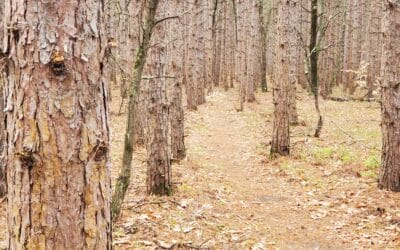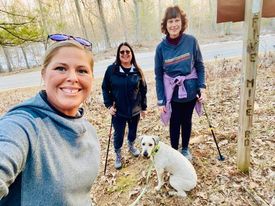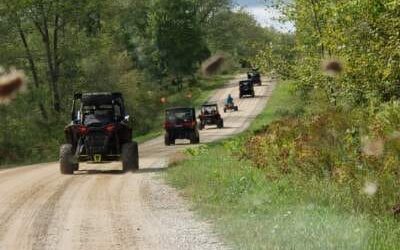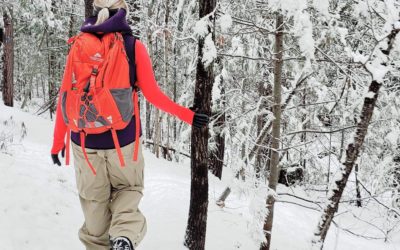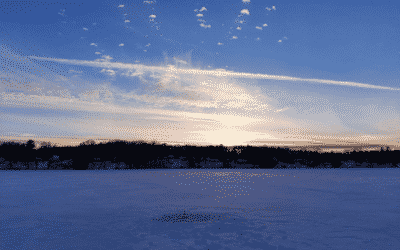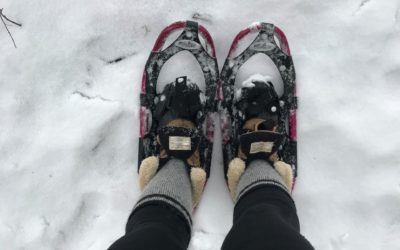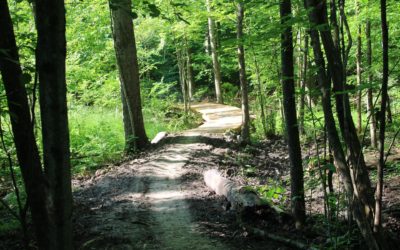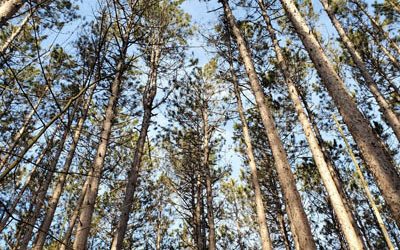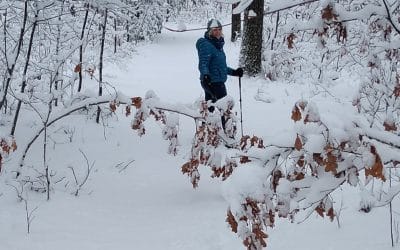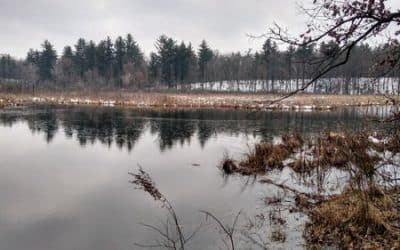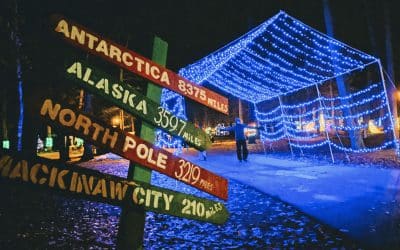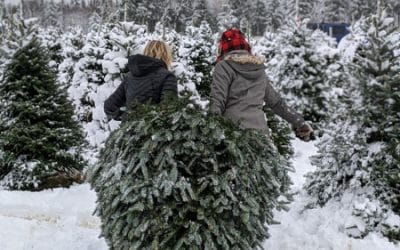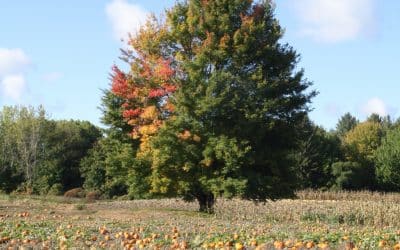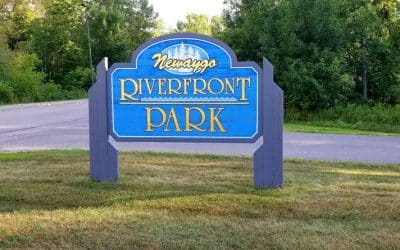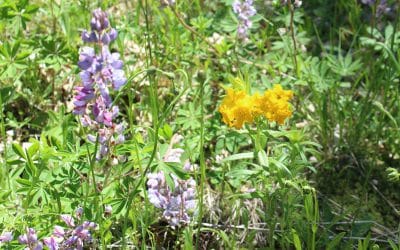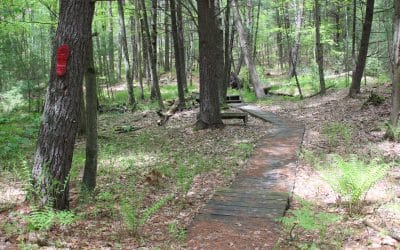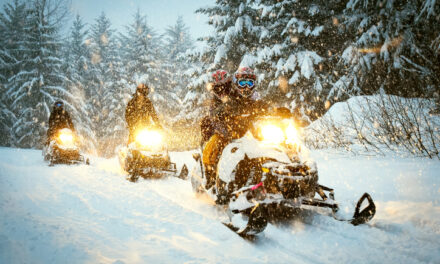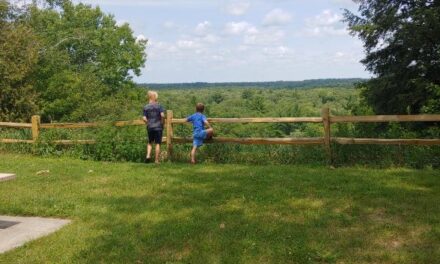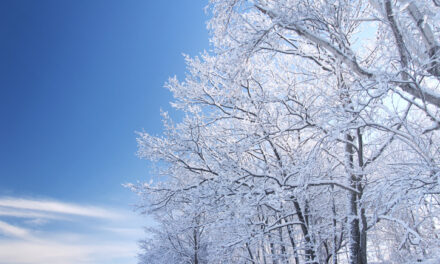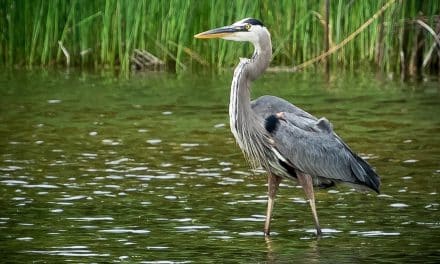By Samantha Breza
Want to do something new this winter? Try snowshoeing!
Snowshoeing is an easy sport to get into. The equipment is relatively cheap, snowshoers don’t have to register the equipment, or pay annual fees for it. Snowshoers don’t need to take classes or have special training to begin.
Traditionally snowshoes were used for getting around in snow without sinking into it with each step. They were used for hunting, trapping, collecting firewood from forests, or for doing daily chores on a farm. Using them for recreational use, such as hiking trails in the winter and competitive racing started a little over a hundred years ago, but snowshoes have been around for thousands of years. No one is entirely sure when the first snowshoes were invented, but archeologists think this happened in Central Asia around 4000 B.C. and were walked over the Bering Strait by the ancestors of modern Native Americans. The first snowshoes were most likely made of rawhide leather, wood, or bark.
Snowshoes have traditionally been made out of wood but most are made out of aluminum or plastic now. At different points in the twentieth century different manufacturers such as Tubbs and Atlas started to use aluminum to make snowshoes. There are a few differences between modern and wooden snowshoes. Modern snowshoes tend to weigh less, which means they are smaller than traditional snowshoes because they don’t need to balance out as much weight. Traditional snowshoes weaved wood across their frames whereas modern snowshoes use synthetic webbing to dispense a user’s weight. Whether they are aluminum, plastic or wood, every snowshoe has the same components. They have a board frame with webbing or lacing in it to prevent sinking into the snow. Snowshoes have turned-up tips at the front (or toe) that prevent snowshoers from getting stuck in loose snow. There are straps and a toe cord to keep feet on the snowshoes and a hole under the forefoot to let snowshoers flex their toes. Often there’s a tail at the end for extra stability.
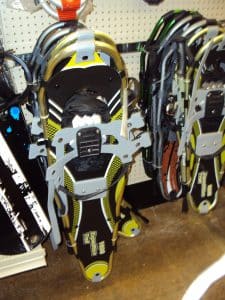
Snowshoes models come in four basic types, but are called by several names and are used for different reasons:
- The Yukon, Alaskan, Pickerel, or trail style snowshoe is oblong and usually four to five feet long and a foot wide. It has a turned-up toe and a long tail. It was made to walk on deep heavy snow over flat terrain, but can also be used to walk down steep hills on soft snow.
- The Ojibwa snowshoe was first crafted in Central Canada, which has wide-open areas that are coated in deep snow every winter. It has a long tail that points up and a pointed turn-up toe, and comes in many different sizes. Modern snowshoes come with spiky metal traction devices under the snowshoes that grip the snow.
- The Algonquin, beavertail, Maine, Michigan, or Huron snowshoe is ten to twenty inches wide and thirty to forty inches long. It has a long tail and a very flat toe and closely resembles tennis rackets.
- Bearpaw snowshoes are shaped like ovals and are mostly flat. Some newer models have a tapered tail design, a raised toe, and size adjustments so they can travel through underbrush and thickets. They have been traditionally used for going up steep hills. Sizes vary dramatically, but the popular Green Mountain bearpaw model is ten inches wide and thirty-six inches long.
Most important is that the snowshoes fit, can support the wearer’s weight (including their winter clothes and supplies), and can transverse the snow and terrain the snowshoer is on. The Algonquin and bearpaw snowshoes are best for hills and mountains, while the Yukon and Ojibwa snowshoes were made for flat land. How big the snowshoes have to be depends on the snowshoer’s weight, what they are carrying, and what kind of snow they’re going to be on (it’s easier to sink in powdery snow). Snowshoe manufacturers post this information on charts in their catalogs and websites. Retailers can also give you similar advice.
Once you have your snowshoes just put them on and walk in them. Walking in them is relatively easy. A wider stance accommodates the snowshoes best. Snowshoers shouldn’t lean backwards when descending a hill and should keep weight on their toes when they go up a hill. Turning in snowshoes required big graceful circles or U-turns. The rest involves putting one foot in front of the other.
The Snowshoes Experience by Claire Walter
Birthday Hike
Is there even a better way to spend your birthday than trekking through the North Country Trail? I think not. After tackling the stretch from M-20 to Echo Drive, I felt ready to make it all the way to 40th street. My father-in-law even gifted me a decades old...
Advice from a Hiking Trio
Meet Annie Trapp, Linda Trapp, Kathy Broome & pup Novalee, all residents of the White Cloud area. They enjoy hiking the North Country Trail as a trio in their spare time. I caught up with these ladies to ask how this year has been going so far…So far in 2021 they...
Modern Workhorse or Adventure Machine?
Back in the day, if you could have looked in a cowboy's saddlebags, you would have seen a few things that every one of them made sure they had whenever they jumped onto their trusty steed. A good rope, a coffee pot and a few tools were part of every cowboy's gear....
Winter Hiking – Questions From a Newbie
Excited to throw 2020 behind me & crush all the goals in 2021, I signed up for the North Country Trail Hike 100 Challenge. Ambitious, as I’ve only hiked a handful of times in my life, but why not make 2021 my year? I embarked on my first hike in the first few...
What do a mousie, a sucker, a spike, and a shiner have in common?
Most people are racking their brains to put these common words together. However, a few winter sportsmen are chomping at the bait to answer this simple question. In our household, these words trigger excitement and remind us of good times with friends throughout the...
Snowshoe Adventure On The Dragon
Being an avid runner from a young age and now a personal trainer, I have spent a lot of time running and hiking over the years. In more recent years, due to my work schedule, I found myself stuck to the convenience of the gym equipment. During the 2020 Quarantine...
Deer Hunter’s Must-Do in Newaygo County
The trees are bare, the air is crisp and the calendar has just flipped to November… In Northern Michigan, that means deer hunters are headed to the woods! If you haven’t tried your luck in the deer woods of Newaygo County, we recommend checking it out. With...
Fall Colors: A Bird’s Eye View
Flying amidst the clouds, high above Newaygo County, Doug Harmon captured Newaygo County's fall beauty perfectly. It's the season, jump in your car and head North! Newaygo County is here to greet you. Grab a bite, even stay the night! Come explore the rivers,...
Sandy Beach Camping
My favorite part of the camping, is waking up early in the morning. When the campground is quiet. I usually get up before the sunrise, to take a quiet stroll around the park.
First Time Hiker
I’m a bit embarrassed to admit, that even growing up next to the Manistee National Forest, literal minutes from the North Country Trail, my first time hiking it was this past winter… in my mid 30’s! While my preferred adventure typically includes a glass of wine on...
Traipsing Through the Winter Woods
I am in love with Newaygo County. We’ve lived here three years now and keep discovering hidden treasures. If you love to be out in nature as my husband and I do, then each season brings new adventures and experiences.I did not think snowshoeing sounded like much...
Winter Wanderings: Newaygo County’s Trails
I first learned to love cross-country skiing during my senior year of high school after befriending a Norwegian exchange student named Ingvar. My first trip out was perfection. A snow day from school and the type of snow globe snow falling through the trees onto us...
Christmas Season Festivities
I grew up in Newaygo country. My memories of the area are rich odes to the senses. There’s the feeling of the cold river running over my feet in the summer, sunlight on my face as it blinked through the rustling tree branches along the bank. There was the taste of...
Church’s Tree Farm
Finding the right tree!Snow fell, and we said goodbye to fall as if it were a thing that never existed. There were never leaves of red, yellow, or orange decorating the skyline. There were no greying trees of exposed branches and bark. There is only this place, this...
Fall Color Tour Time!
Top 5 places (and maybe a few more) to take great Fall color photosFall is my favorite time of year. I love watching the rainbow of colors change from day to day. Science says that water and temperature determine when a tree’s leaves turn colors. I don’t much care for...
Newaygo’s Riverfront Park – A Great Place to Walk Your Dogs!
We have 14 acres and some nice trails on our property that our dogs get walked on regularly, but we try to get them out for a ride in the truck and a walk “elsewhere” as often as we can too. They really like walks in the woods but sometimes, especially after work, we...
Flowers are Popping at Loda Lake Wildflower Sanctuary
This darn crazy spring and summer weather we are having is making it frustrating for photographers. I went to Loda Lake this week on the only day it hadn’t rained and was surprised by how I was joined by other photographers and hikers doing the same thing. School is...
Coolbough Natural Area Offers Birds, Bugs and Boot Prints
The Coolbough Natural Area is one of my favorite places to hike. Why? There are many reasons such as easy parking, looping paths, lots of wildlife and points of interest, a porta-john, and many more, but I will save my favorite for last.Coolbough has many options for...

